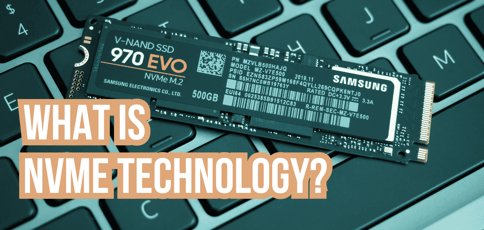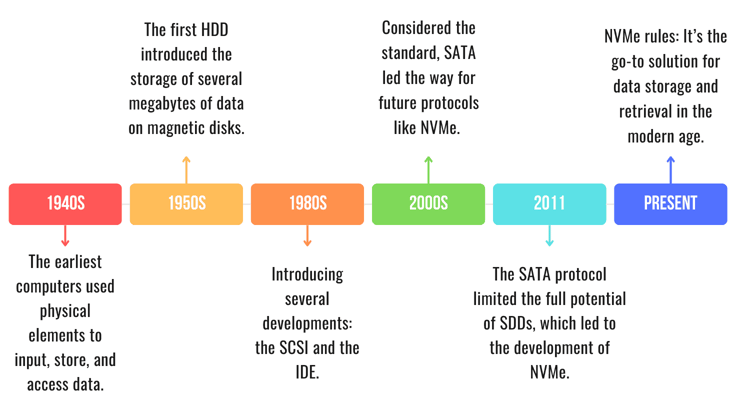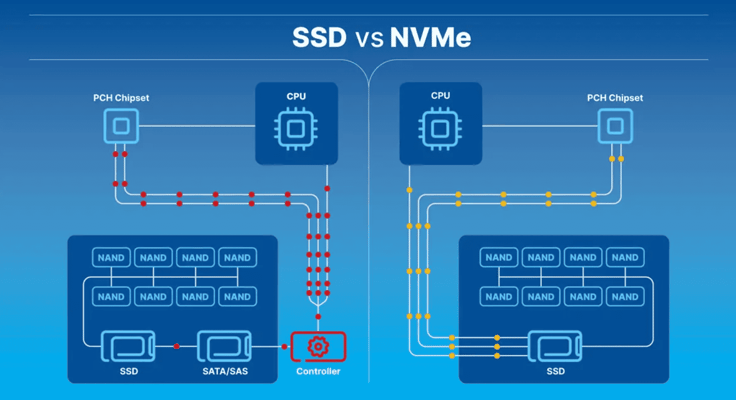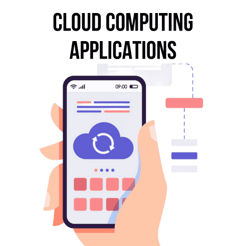
NVMe, or non-volatile memory express, is a storage protocol for accessing media items, files, and documents in storage units like SSDs (solid-state drives). The NVMe protocol works on computers and servers to access and transfer data significantly faster than older protocols like SAS and SATA.
Operating through what’s called a PCIe (peripheral component interconnect express) bus on a computer, the NVMe protocol provides an efficient way to pull data from an SSD, and it’s the only protocol that takes full advantage of the potential of SSD technology.
Real-world applications include high-performance computing, web hosting, data-intensive applications, and big data analytics. A drive that uses NVMe dramatically increases data retrieval speeds, leading to faster processing and improved performance for everything from websites to applications. Another advantage of NVMe in the modern world of high-speed computing is its ability to support more parallel operations, adding to the performance increases found with the protocol.
-
Navigate This Article:
Understanding NVMe Technology
To understand NVMe technology, you must first look at the evolution of storage technologies. It’s also important to explore how the NVMe protocol and SSDs work together, along with all the features and benefits that come with NVMe storage.
Evolution of Storage Technologies
Before the introduction of NVMe, several storage retrieval protocols came about to speed up how computers access and return data for applications, websites, and other uses. The earliest computers, dating back to the 1940s, used physical elements — punch cards and magnetic tapes — to input, store, and access data.
In the 1950s came the first HDD, or hard disk drive, which introduced the storage of several megabytes of data on magnetic disks. The 1980s saw several developments, including the small computer system interface (SCSI) and the integrated drive electronics interface (IDE).

Serial ATA (SATA) was the first storage protocol to improve upon the performance offered by IDE. Considered the standard for retrieval of media and data from HDD hardware and optical drives throughout the 2000s, SATA led the way for protocols like NVMe.
In terms of storage hardware, introducing SSDs presented a notable leap forward in data access speeds. Unfortunately, the SATA protocol limited the full potential of SDDs, which led to the development of NVMe in 2011. The NVMe protocol took full advantage of high-speed SSDs, making it the go-to solution for data storage and retrieval in the modern age of computing.
NVMe SSDs Explained
Designed for modern solid-state drives, the NVMe protocol works with two hardware components inside a computer: the SSD and the PCIe bus. The SSD functions as the high-speed storage element where data files get placed. The PCIe bus is the hardware that interconnects various computer elements like SSDs, graphics cards, and the computer’s processor.
With these direct links to many items within the computer, NVMe maximizes the power of both the PCIe bus and the SSD to deliver increased performance, lower latency, and less power usage. Overall, the NVMe protocol presents a more efficient, cost-effective, and high-performance solution for moving data throughout a computer.
Key Features and Benefits
With NVMe technology, computers finally have the chance to use the high-speed capabilities of modern PCIe buses and SSD hardware. Its key benefits, especially when compared to the SATA protocol, include speedier access to data from the SSD, lower latency, and scalability. With less latency, computers can access data almost instantaneously, making it ideal for high-performance computing and data-heavy application use.
When a website or app needs to deliver pictures or data files to the user, NVMe provides nearly real-time processing, so these sites and applications minimize lag time and improve the overall user-experience on anything from eCommerce websites to the applications used on your smartphone.
Along with all that, NVMe allows for an increase in parallel operations (when compared to SATA), making it ideal for the scalability of an operation that uses cloud computing or virtualized environments. For example, a cloud hosting or VPS system can work on a large number of tasks at once instead of struggling with its performance as tasks build up.
How NVMe Technology Works
Most people look at NVMe technology and simply assume it’s a better, faster technology, so they opt for hosting providers that use it. However, it pays to actually understand how NVMe technology works so you know if it’s right for your business — and to prepare for future advances in storage technology.
Architecture of NVMe
NVMes work in conjunction with non-volatile storage media like SSDs. Its command set, designed particularly for SSDs, offers commands for:
- Error reports
- Dataset management
- Basic read/write data transfers
- Error management
The SATA protocol was designed for slower hard drives with moving parts. This mechanical nature of the hard drives resulted in slower processing. NVMe, on the other hand, operates with solid-state drives (no moving parts), which makes for a purely digital data transfer process. The command set, therefore, remains efficient and lean, never relying on whether a mechanical component can move fast enough.

NVMe also has an advanced queuing system. Older technologies like SATA only provided individual queues that could process 32 commands at once. NVMe, however, runs 64,000 queues together, allowing for a maximum of 64,000 commands simultaneously. In short, NVMe retrieves more data at one time, which reduces latency and delivers much faster access to storage.
PCIe Interface
Modern server hardware uses a physical component called the peripheral component interconnect express, or the PCIe interface. The PCIe bus links all storage devices within a server to the RAM (random access memory).
Simply put, the PCIe bus functions as the road that the NVMe protocol uses to transfer data from an SSD storage component to the end user. The PCIe interface offers several lanes for moving data both to and from the SSD. Performance increases because of these multiple lanes since they remove any bottlenecks that may have come from less advanced technologies.
Command Queuing and Parallelism
Two helpful performance features of NVMe include command queuing and parallelism. Command queuing applies to how a computer can handle and hold multiple read/write commands in a queue and process them for output.
With NVMe, the number of queues goes up to 64,000. Every one of those queues supports 64,000 commands. Compared to the SATA protocol (which only had one queue that supported 32 commands), NVMe command queuing boasts higher transfer rates and a massive improvement in the number of simultaneous data transfers.
This simultaneous data transfer, when combined with the multiple lanes provided by the PCIe bus, is what’s known as parallelism. The data channels run side-by-side and all at once, leading to an increase in performance throughout the computer.
Advantages of NVMe
The advent of NVMe helped to build upon performance speeds and storage efficiencies of past technologies like SATA. That’s because of the various advantages NVMe brought about by using the potential of the PCIe interface and SSDs. Below, you can read about the most important advantages that come with NVMe:
- Blazing fast speeds: NVMe, in tandem with the PCIe interface, delivers much higher data transfer rates than older protocols like SATA. For applications and websites, this means faster file transfers and loading times. It also allows for faster boot times for software and applications. Everything is faster, leading to a smoother, more responsive user experience.
- Lower latency: Reduced latency, or the decrease in delay when transferring data, is a key advantage of NVMe technology. The PCIe interface and NVMe protocol reduce latency compared to SATA and older protocols. This leads to a smoother user experience, more efficient server operation, and faster, better responsiveness from apps and websites.
- Enhanced scalability: Businesses that need to scale can take advantage of NVMe because of its higher number of queues and commands. With 64,000 queues and 64,000 commands, NVMe handles simultaneous connections and operations with ease. Therefore, as a business grows, NVMe is better equipped to support fluctuations in traffic, rapid increases because of growth, and the constantly evolving storage demands from businesses like eCommerce stores and app creators.
With these advantages, NVMe SSDs provide high-traffic websites and data-heavy applications with the speeds needed to offer a seamless, user-friendly experience. In short, it leads to reduced latency, faster page load speeds, and less frustration for the end user.
Use Cases and Applications
NVMe technology is used in a wide variety of industries. Its use cases and applications continue to grow. The main applications include consumer electronics, enterprise applications, and cloud computing.
Consumer Applications

Consumer applications — apps downloaded directly from app stores on computers, tablets, and smartphones — have taken full advantage of NVMe technology for improved performance and boot times.
Gaming applications, for instance, enjoy smoother gameplay, the rapid saving and loading of game states, and quick game loading for the best user experience.
Consumer applications for creating documents, spreadsheets, and databases experience higher data retrieval rates as well.
Content creators benefit from NVMe, too, seeing as how they can edit videos and render edits much faster thanks to the improved read/write speeds of NVMe.
Enterprise Applications

Enterprise applications — those with higher data demands for large enterprises — often require superior data transfer rates for their data-intensive applications.
Thankfully, NVMe delivers incredibly fast data access speeds, improved data processing, and efficient responsiveness.
These all help enterprises make decisions faster, especially for processing time-sensitive information and looking at real-time analytics.
Cloud Computing Applications

Cloud computing requires the immediate retrieval of data stored in the cloud in order to mimic localized technologies.
With NVMe, cloud computing can achieve real-time data access and transfer, particularly because it optimizes storage performance and enhances delivery speeds.
As a result, cloud computing providers can offer support for reliable and consistent user experiences and the scalability of growing data volumes.
How to Implement NVMe Technology
For many users, NVMe technology simply comes with services like web and application hosting. However, those users may also want to install an NVMe SSD on their own machines, or service providers might need help implementing NVMe technology to provide to users. Follow the recommendations below for effectively implementing NVMe technology.
Compatibility Considerations
Compatibility plays a significant role in whether you can implement NVMe technology on a machine. Before going through the process, ensure that the motherboard on your machine supports NVMe technology.
You can confirm this by looking at the motherboard’s manufacturer website or user manual. It’s also important to check if the machine has enough PCIe lanes for the best NVMe performance. Again, you can find this information on the motherboard’s manufacturer website or user manual.
Installation and Configuration
Installing an NVMe SSD takes a series of steps that vary depending on whether you install it on a desktop, laptop, or server. To install an NVMe SSD on a computer or laptop, you’ll need the computer, an appropriate screwdriver to open the computer, the computer’s manual, and the new NVMe SSD. Be sure to review the compatibility considerations (in the section above) before starting anything.
Here’s how to install an NVMe SSD on a desktop or laptop computer:
- Back up all important files to an external drive.
- Shut down the computer and remove all cables.
- Remove the battery. Look at your computer’s manual if you can’t figure it out. Some machines require you to unscrew some screws and open the computer to remove the battery.
- Open the computer case with a screwdriver. Again, refer to your computer’s manual for the safest way to do this without damaging the computer or causing static shocks.
- Locate the M.2 PCIe slot (here’s what that looks like) that will hold the NVMe SSD. For desktops, this is usually easy to find, but laptops generally have it under the bottom panel or keyboard.
- Grip the SSD by its sides. Insert the SSD into the slot, but avoid touching the gold connector pins. Align the connectors between the SSD and PCIe slot.
- Secure the SSD. Some PCIe slots will click and hold the SSD. Others rely on framing with screws to hold it down.
- Reassemble the computer.
- Power the computer back on.
- Go to the manufacturer’s website to download the right drivers to the NVMe SSD.
The very last step is to initialize the SSD. You can complete this process using your computer’s disk management tool. Once there, click to initiate or activate the new NVMe SSD.
Optimization Tips
Any implementation of the NVMe protocol requires optimization. To begin, you should consistently update the drivers and firmware on your hard drive. These come from the manufacturer to fix issues and enhance the overall operation of the drive.
You can find these on the manufacturer’s website. Another tip is to use an SSD management utility. This utility helps manage your drive’s storage while also boosting performance and monitoring its health.
Challenges and Considerations
With all new technology, you may encounter challenges. From costs to future-proofing, you’ll find that NVMe has some challenges to consider during the implementation process.
Cost Considerations
When compared to older storage technologies, NVMe is more expensive. For instance, a web host that uses traditional SATA HDDs and SDDs costs less. Many businesses consider SATA drives suitable for their budgets, but it’s essential to consider the higher efficiencies and potential revenue increase thanks to NVMe drives.
An eCommerce store, for example, could justify the added cost of an NVMe drive by knowing that a smoother user experience could increase sales.
Data Migration
The migration of data from a SATA SSD/HDD to a newer NVMe SSD requires careful execution. You must put together a plan to prevent the loss or corruption of data in the process. A data backup plan comes into play to avoid the challenge of data loss.
It’s also essential to pick a smooth migration method like a manual transfer or cloning of the data. These methods minimize downtime, too.
Future-proofing
One constant challenge of implementing any new technology involves how that technology may last into the future. Therefore, any NVMe investments must go through the process of future-proofing.
Before adding an NVMe SSD, it’s crucial to make a plan for updates whenever they come out for hard drives. In addition, you may have to account for potential replacements or upgrades for the drives. Ideally, you opt for scalable and upgradable technology, whether that’s going with a provider that plans to upgrade its resources and protocols or investing in upgradeable NVMe technology for your own machines.
Case Studies
Businesses and hosting providers continue to implement NVMe technology for its superior performance and storage speeds. To see how it can improve your business, take a look at the case studies below. They explore several organizations that have adopted NVMe technology and seen drastic improvements in efficiency and performance.
Case Study 1: Complete.
Complete., a digital marketing agency focused on data-driven strategies for businesses around the globe, turned to Cloudways to migrate all of its data storage to an NVMe SSD.

The agency manages multiple websites for its large collection of clients and, therefore, needed a more reliable and high-performance data storage solution. As a result of the migration to NVMe, Complete. cut website load times by 50%.
Key Takeaways
- NVMe can improve page load times, uptime, and response times, as well as support the cleaning of data.
- Many migrations to NVMe, like in the case of Complete., come with additional benefits. For instance, Cloudways provided security and maintenance improvements for the business.
- NVMe can assist in customer communications, like how Complete. strengthened its reliability of transactional emails to customers.
- An NVMe configuration helps businesses that serve hundreds or thousands of websites, since you can put all of those websites on one hosting platform that offers NVMe.
Another advantage of going with a hosting provider with NVMe is that they often have reasonable pricing packages that scale as your business grows. Cloudways, for example, helped Complete. find a pricing package that fit into its budget.
Case Study 2: Disruptor Beam
The team at Disruptor Beam, a social gaming development company, encountered issues during its launch of a Game of Thrones role-playing game.

The company needed faster, accessible storage to minimize lag time and the game’s lack of availability. Therefore, it migrated its data storage operations to a Liquid Web dedicated SSD drive that uses NVMe technology. Many of the problems came from read/write concerns, so the shift to an NVMe-capable SSD mitigated those issues, especially during peak gaming periods.
Key Takeaways
- It’s possible to combine a dedicated NVMe-focused system with a cloud-based hosting solution, similar to how Disruptor Beam used the NVMe for “mission-critical, custom systems,” while tapping into the cloud for scaling.
- A dedicated NVMe can actually lead to cost savings, like how Disruptor Beam was able to separate its development and testing environment from its actual production function. This helped them save on equipment and operational costs.
- Making a change to an NVMe drive always provides an immediate boost in read/write processing. With Disruptor Beam, the brand instantly gained the ability to support significant spikes in traffic.
Although Disruptor Beam used a dedicated server, its operations remained in a hybrid hosting environment. It shows the flexibility of newer hosting technologies like NVMe and cloud hosting, since they can often work together.
Case Study 3: Ribbet
Another Liquid Web success story revolves around a browser-based photo editing app called Ribbet.

With more than 1.5 million users and the need to store photos online at an alternative location, Ribbet found that shifting to a dedicated server with NVMe storage allowed it to manage the millions of photos and read/write requests it receives.
Key Takeaways
- Along with NVMe technology, it helps to have load balancing and scalable servers to handle peak usage times (for Ribbet, that was during the afternoon).
- You can’t put a price on reliable web hosting. The Ribbet CEO explains that even spending more than double for an NVMe (and quality customer support) pays for itself since you avoid the irritation that comes with a budget hosting provider.
- Even some cloud platforms can’t offer what a dedicated NVMe provides. Ribbet’s cloud-based Linux operating system was approaching its end of life, so it used that opportunity to switch to a dedicated server with NVMe, taking advantage of the perks of NVMe in the process.
It’s also worth noting that the CEO of Ribbet kept harping on the importance of quality customer service. With any type of hosting, there’s nothing more frustrating than dealing with an unknowledgeable person who is only replying based on what a script says.
Navigating the Fast Lane With NVMe Technology
With NVMe technology, businesses can move into the modern world of computing, while also elevating their data storage limits to a new level. The simple comparison of SATA vs. NVMe (32 commands vs. 64,000 commands) shows that hosting with the NVMe protocol is far superior to older technologies.
If you seek improvements in storage performance and efficiency, NVMe is the way to go. We encourage you to explore NVMe storage solutions to unlock the potential of your computing environments and to bring reliability and high speeds to anything from app development to eCommerce websites.







